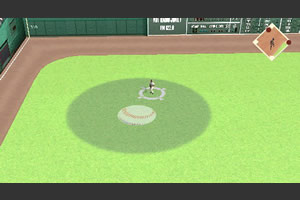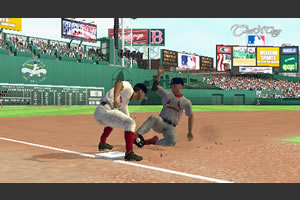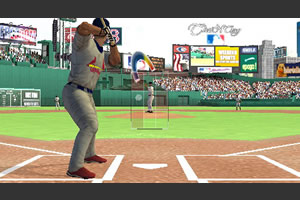A shallow hit.
Ostensibly a port of this year’s MLB 2006, MLB for the PSP seems to be made of the same stuff as its older brother. All of the gameplay is intact, from the chargeable pitching meter to the big, weird, spinning baseball field-markers. But MLB 2006 for the PS2 also packed in tons of career, franchise and online options. There was enough content in that game to keep a fan happy for months.
MLB for the PSP, however, has been put on a strict diet by only offering Season and Exhibition games, plus a somewhat broken online component. It’s all the fun with none of the depth.
In Exhibition games you can choose your pitcher, set a batting order and play a single game. The Season mode is definitely more complicated, allowing you to set pitcher rotations, trade players, track stats, and basically play a full season. However, you don’t get any farm leagues and you can’t hire or fire staff, so any talent or developmental angles are missing.
Thankfully, MLB has the same solid gameplay found in MLB 2006. The pitching element uses the release-point scheme found in MVP 2005, although MLB‘s meter is a bit more difficult to read. You simply select a pitch type and location, charge the meter for power and then press the button again for accuracy.
The only difference is that when you place any sort of breaking pitch, from a curveball to a change-up, the break isn’t taken into account. So if you’re throwing a curve and want it to wind up just underneath the bottom edge of the strike-zone, you’ll actually want to place it waist-high. After you throw the pitch, assuming it isn’t hit, you’ll see where you aimed it and where it wound up, giving you an idea of how your pitches are breaking so you can place them more accurately.
This is a cool system because you can’t sit there and throw curveball after curveball right into the corner of the strike-zone. Instead, you have to anticipate the break and either have your pitch slice through the zone or risk hanging it. What initially seems like a pale-imitation of MVP‘s pitching model is actually a pale imitation with a really nice, hardcore twist.
With one major downside. For some reason, MLB doesn’t allow you to use the D-pad to place your pitches, meaning you must rely on the thumb-nub…and the nub is not up to the task. I’ve sat for minutes trying to perfectly place a pitch, only to have the cursor jerk back and forth between two unwanted points. Meanwhile, the D-pad sits there, useless and unburdened with any other task.
The batting system is the same one MLB games have been using for years and changes based on your difficulty setting. If you play on the Rookie setting, you only need to worry about timing your swing. If you correctly guess the pitch type, you’ll lock on and hit the ball with some extra oomph. On Veteran, you’ll only lock on if you guess the pitch location, and on All-Star you’ll only lock on if you guess both type and location. If you guess the incorrect location on All-Star difficulty, you will never make contact no matter how spot-on your timing.
 This system isn’t new, although it is still pretty good. It’s especially effective against human opponents because they are more likely to get locked into basic patterns than the game’s seemingly random, nonsensical A.I. Seriously, the computer leads off with two change-ups, then throws a high curveball outside the strike-zone – how are you ever going to see that coming? Even though this system is hardcore and has been popular for years, it doesn’t pack the punch it used to, especially thanks to the brilliant Batter’s Eye feature that was included in EA’s MVP 2005.
This system isn’t new, although it is still pretty good. It’s especially effective against human opponents because they are more likely to get locked into basic patterns than the game’s seemingly random, nonsensical A.I. Seriously, the computer leads off with two change-ups, then throws a high curveball outside the strike-zone – how are you ever going to see that coming? Even though this system is hardcore and has been popular for years, it doesn’t pack the punch it used to, especially thanks to the brilliant Batter’s Eye feature that was included in EA’s MVP 2005.
MLB‘s fielding is actually more intuitive than it was in MLB 2006, thanks to the fact that both jumping and diving have been allocated to the R button. In this role, the R button is basically the extra effort button; if you don’t think you’re going to make the catch, you press R every time. Fielding fly balls can be a little tougher to figure out. When a ball is hit in the air, a huge spinning baseball on the ground indicates roughly where it is going to come down. As the ball gets nearer, the image spirals down to a point where the ball is actually going to land. If your fielder isn’t right on this point, he won’t catch the ball, so you constantly have to make adjustments. The system works, but it just doesn’t look clean.
If you find the game too easy or hard you can tweak some of the tuners (there aren’t a ton, but the important ones are present). It’s just too bad that you can’t tweak a “Game Depth” setting, because MLB would really benefit form MLB 2006‘s signature Career mode. You can also use the fast-forward feature to skip to any half-inning at any point in a game, but considering gameplay is all MLB really has going for it, there’s little reason to skip innings or simulate games.
With such skimpy offline content, MLB‘s long-term playability depends greatly on its Infrastructure play. If, for example, MLB had a robust suite of online features that would keep players competing against one another until the next entry in the series hit shelves next year, we wouldn’t mind the anemic single-player assortment.
No such luck. MLB has one of the worst, most stripped-down lobbies we’ve ever seen. It shows names, and that’s it. No rankings, no “Disconnected from X number of games,” no latency, nothing. Your only option in the lobby is to challenge other players, and even this isn’t as simple as it sounds. Every time I tried to challenge another player I got a message saying “Challenge failed,” and I still don’t have any idea what that means. Did the person decline my challenge? Did something time out? Did I not study hard enough?
 At any rate, I eventually learned to wait for challenges and accept them. Unfortunately, this almost always led to playing incredibly laggy, boring matches. Not all were atrocious, but finding a good one meant joining game after game and quitting over and over until I happened on a match with a decent ping. Once I managed to find such a player, things would proceed decently except for the fact that neither of us could change any parameters to our liking. All games have to be nine innings and must be played at the Veteran difficulty level.
At any rate, I eventually learned to wait for challenges and accept them. Unfortunately, this almost always led to playing incredibly laggy, boring matches. Not all were atrocious, but finding a good one meant joining game after game and quitting over and over until I happened on a match with a decent ping. Once I managed to find such a player, things would proceed decently except for the fact that neither of us could change any parameters to our liking. All games have to be nine innings and must be played at the Veteran difficulty level.
So yes, you can play MLB online, and you might even find one or two good games, but the fact remains that this is a mostly broken, outrageously underdeveloped feature that will not extend your enjoyment more than a smidgen.
Still, MLB plays well enough and looks good, too. The ball zips off the bat when struck, players transition seamlessly from running to diving, and throws from base to base are crisp and sharp, especially during double-play attempts. The framerate does occasionally dip, but fliud animations and transitions greatly outnumber shoddy ones, except when you play online.
Where MLB skips the occasional frame, its commentary never misses a beat. Matt Vasgersian and Dave Campbell provide surprisingly accurate, astute observations, occasionally catching you off-guard with particularly insightful references to your previous games. The sound effects are also decent, although the poppy soundtrack will make you hate sound until you manage to turn it off
MLB does a great job of mimicking MLB 2006‘s look and feel. For forty bucks you can hop on a bus and play a relatively entertaining game of baseball complete with mound visits, stolen bases, and drag bunts. The missing career modes and broken online features are hard to ignore, though, so don’t expect this one to get you through the whole season.









